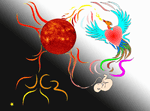« We fail to fully translate what our soul feels :
thought remains immeasurable with language » Henri Bergson (French philosopher) |
At the source of communication.
Human language expression manifests itself in two forms : spoken and written. How did they come about, how did they evolve ?
2 – The evolution of human communication – from verbal language to mathematical languages :
A – Defining language :
a – Definition :Language can be defined as a system of communication that allows an individual or a group to exchange ideas, thoughts and emotions, and explain situations, through sounds, words, body language and symbols.
It has become an indispensable means of communication for ensuring the cohesion and development of human societies.
This term refers to both :
- the ability to represent a concrete thing or an idea, which is called a concept.
- the language that allows a people to communicate.
However, opinions differ among Greek philosophers. Plato argues that language enables effective communication, while Gorgias believes that it cannot represent either objective experience or human experience because it highlights the difficulty of conveying reality. It can be imprecise and clash with the listener's interpretation. It can even go so far as to express an idea that is contrary to reality, and this is then called a ‘lie’ or « misinformation » which we are all familiar with today.
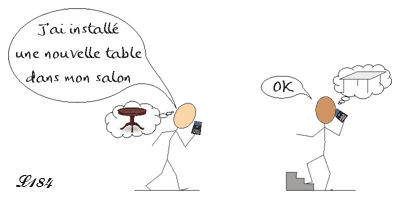
The communication was effective because the object is recognised...

...but it is imprecise because it does not say what the table looks like.
What about the language of dreams ? Are their images imprecise or, on the contrary, too detailed ? Do they convey the reality of events, or only the dreamer's reality ?
b - A complex set of systems, controlled by the brain :
Human language is a complex system that requires the acquisition, development and coordination of various communication organs that other species do not possess in such a developed form. This difference has perpetuated the idea that humans are the only species to possess language.
In fact, in order to access spoken language, the brain must master many skills.
- perceiving sounds and images and storing them in its memory,
- analysing sounds according to their intensity and frequency, or images according to their shapes and colours,
- understanding them,
- producing the necessary words and organising them,
- transmitting information using sound-producing organs.
c - Language, an unreliable translator for conveying the richness of thought :
Some philosophers, such as Hegel, believed that language does not serve to communicate our thoughts, but rather constitutes them.
For his part, linguist Ferdinand de Saussure said that, "apart from its expression in words, our thought is nothing but an amorphous and indistinct mass ".
Indeed, we are so accustomed to reasoning with the support of words that, without them, our thoughts seem vague and elusive.
This is why Hegel could say that ‘wanting to think without words is a senseless endeavour’.
There is a reason for this : the language that formalises our thoughts passes through a cerebral tool that translates sensations into words. However, thought is primarily concerned with processing information from the senses.
Thus, by attaching itself to a succession of words that betray reality by simplifying it to the extreme, it has lost its connection with what gives it meaning.

Thought linked to sensations.
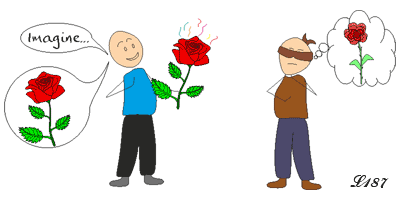
Thought translated by language – loss of smell and simplified image.
How many times, when trying to express a new idea or a particular feeling, have we exclaimed, ‘I can't put into words what I'm feeling’.
Our thinking is not vague; it instantly expresses a need and, through emotion, directs an immediate reaction.
Language must freeze it and reorganise it according to social criteria before allowing a reaction.

Feeling of danger > Flight
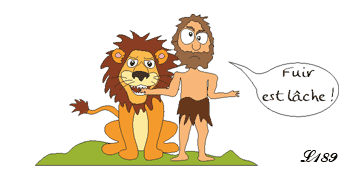
Reflection in the face of danger > Too late.
Indeed, we have now managed to describe the world word for word, but we have become incapable of perceiving it in depth.
What, then, can we say about language ?
First of all, language structures and transmits our perception of the world as best it can.
This is how anthropologists E. Sapir and B. L. Whorf were able to show that different languages reflect different perceptions of the world : for example, the Inuit, who live in a snowy world, have a very rich vocabulary to distinguish between different types of snow and ice.
Similarly, researchers in constant contact with the animal world can recognise and name each member of a tribe of monkeys [see: From innate potential to specialisation].
In this sense, language suffers the fate of a child's abilities, which can, for example, access the use and understanding of all languages until the mother tongue, by imposing its use, causes the child to lose their ability to adapt. The same is true for facial recognition.
Perception retains a great richness, but its description is developed according to the needs of the community and the extent of its vocabulary.
« By linking his thoughts to words,
man has lost most of his ability to feel. »
man has lost most of his ability to feel. »
B – From verbal language to mathematical languages :
a – The theory of continuity :If we ignore all the stages of evolution and focus solely on the human species, we can see that theories on the origin of language vary greatly :
- it evolved from pre-linguistic systems in our hominid ancestors,
- it arose during the transition from primitive hominids to Homo sapiens,
- language learning is an innate faculty that is partially genetically encoded,
- it is an essentially cultural system.
Today, theories based on continuous evolution are accepted by the majority of researchers. Only the presumed causes of its emergence differ : some consider that it is preceded by cognition, while others believe that it began with animal communication and continued in primates before reaching humans.
These theories of continuity therefore focus on both human language and animal behaviour. For example, birdsong could be a clue for models that suggest language developed from music.
b - The origins of humankind - Proto-language :
Linguists agree on a two-stage development.
Hominids first developed a proto-language, a simple communication system based on meaningful sounds, but without syntax. Syntax then allowed language to evoke more complex situations, set in different times and places, and even imaginary scenes.
Thus, the most widely accepted theory on the origins of language is the proto-language theory put forward by linguist Derek Bickerton in 1990.
Presumed to have been spoken by Homo erectus, this language without grammar would have consisted only of onomatopoeia or sounds evoking concrete actions or objects: ‘tree’, ‘eat’, ‘danger’, ‘walk’, “good”, ‘bad’.
The simple juxtaposition of two or three sounds (or ‘words’) was enough to determine the meaning of the utterance [cf: the vocalisations of the Campbell's monkey].
Perfectly suited to everyday activities, this language did not allow for the development of complex narratives or abstract discourse.
Nevertheless, Derek Bickerton was able to show how this primitive language had evolved into an elaborate system by studying Creole languages. The African slaves deported to the colonies did not all speak the same language. To communicate with each other, they used pidgins, languages without syntax that gradually transformed into real languages : Creoles. This evolutionary capacity can be found in children's language.
While the development of a proto-language without syntax is attributed to the hominina genus, it should be noted that Campbell's mone, from the cercopithecidae family, has a syntax that allows it to describe different situations despite a limited vocal vocabulary.
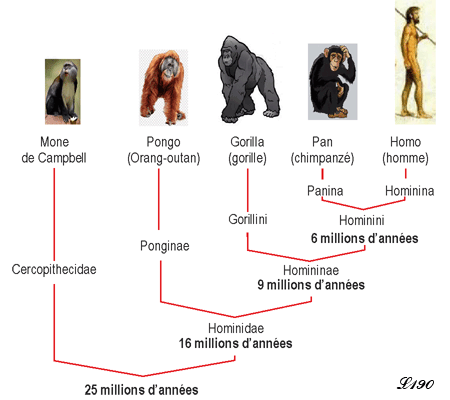
Phylogeny of primates.
Communication based on the juxtaposition of simple sounds may therefore also have appeared and preceded proto-language in our ancestors : in a confined space, this mode of communication was sufficient, as is the case for current species.
Later, the diversity of environments explored during migrations enriched the vocabulary of the homo genus.
The importance of migration is evident in the limited communication of sedentary species, which are perfectly adapted to an ecological niche.
This characteristic also appears in the work of Quentin Atkinson, who, in a database of 504 languages, observed that certain African languages have more than 100 phonemes [see previous chapter], while Hawaiian, which is the language furthest removed from its African roots, has only 13 : the number of sounds produced in a small, isolated territory is much lower than that required by the variety of landscapes and dangers on a vast continent.
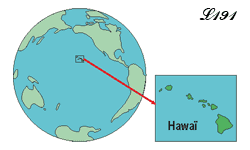 |
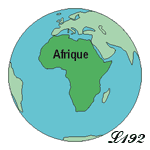 |
Archipel d’Hawaï 13 phonèmes – Afrique 100 phonèmes
« The richness of language is related
to the variety of environments and situations experienced. »
to the variety of environments and situations experienced. »
Among sedentary species, sounds are sufficient for communicating vital information. It is varied environments that give rise to sophisticated language : this language is specific to nomadism.
Today, we can see this development of vocabulary linked to international travel.
c – The evolution of language over a generation :
Although we do not know how language has evolved over thousands of years, we can nevertheless examine how it evolves over a human generation.
The way in which children begin to utter their first words seems to support the proto-language hypothesis.
How do they communicate before they can speak? Although they cannot yet speak, they can hear.
1 - Language development in very young children :
- The first signs of the auditory system appear at 10 weeks of gestation.
At 18 weeks, the cochlea begins to send sound information to the brain.
 |
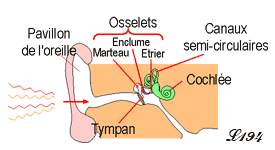 |
Foetus and cochlea.
However, according to scientists, it is not until the 26th week of pregnancy that hearing becomes functional. It then opens up to all sounds coming from both outside and inside the mother's body (the mother's heartbeat or digestive noises).
- The foetus recognises its mother's voice from the 7th month of pregnancy : when it hears her, its heart rate accelerates. It is mainly musical inflections that attract its attention, as it turns away from her if she speaks in a monotonous or shrill tone.
From the eighth month of gestation, the cochlea has completed its development and the foetus's hearing becomes more refined, which is why newborns recognise nursery rhymes heard in their mother's womb.
- They will then learn to speak. At two years old, they are able to recognise that a word is a noun or a verb, and by around three years old, they will have acquired verbal maturity identical to that of an adult.

Egg and sperm, morula, gastrula, foetus, child.
After nine months of gestation and three years of social development, the child has gone from a cell to a developed organism. At the same time, it has gone from communication between cells to communication between children.
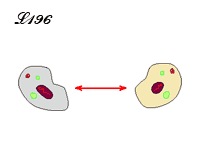 |
 |
From communication between isolated cells to communication between cells within living organisms.
It has acquired all the senses necessary for body language and then speech.
Its maturation is now complete. It may sometimes have been reoriented towards a different form of vocal communication, borrowed from an adoptive animal family, as is the case with feral children.

She-wolf suckling Remus and Romulus.
2 - The sound basis of language :
Although babies are able to hear at birth, they do not yet know how to speak. How do they express themselves ?

Baby cries.
Audio: Baby crying.

Kitten meows.
Audio: Kitten meows.
When comparing the sounds made by cats and babies, we see that they are throat sounds, and that they allow the listener to feel what they are expressing. The emotion felt indicates real communication, even if we cannot yet talk about proto-language.
Could this mode of communication become a language if a grammar began to emerge ?
This is what we find in Campbell's mone, which adds suffixes to its warning vocalisations to indicate the nature and danger of a threat.
Thus, in the Taï Forest in Côte d'Ivoire, the sound ‘hok’ warns of danger coming from the sky.

Hok
Audio : Hok.
If the threat subsides or is less serious (falling branch), the suffix ‘oo’ is added to specify the degree of alert.

Hok-oo.
Audio : Hok-oo.
Could we now compare the animal's vocalisations to human verbal language ? Once again, sound graphs can give us an indication :

Danger from the sky : « Hok »

Graph of human language : « sky alert »
Audio : Human language : « sky alert »
In the first case, the sound is brief and sufficient to alert to danger ; in the second case, the articulated sounds are more detailed, syllables can be discerned, and there is an indication of the time needed to signal the alert.
« Foetal development describes the transition from cell to organism.
The stages of human language acquisition can be found in the development of the child. »
The stages of human language acquisition can be found in the development of the child. »
As we have seen, cells communicate with each other and are capable of perceiving information and storing it for later use, even though the developing child is not yet able to communicate these discoveries.
Throughout their evolution, cells seek out information from increasingly distant sources. Adult humans are no exception to this process, which leads them to search even the depths of the universe for information that could be considered useless.

Cosmic microwave background radiation.
Nerve cells in particular also communicate with each other even before the living being whose actions they coordinate communicates with another through language...
Consciousness (whose potential we have seen develops from the back to the front of the brain) is also the result of information transfer. It begins in our unconscious mind, made up of communicating cells, even before our frontal lobe restores our consciousness.
However, although the “consciousness” of the world seems to begin with the cell, a single cell has limited capabilities...
Its capabilities increase when it joins with other cells within an organism to communicate with other external entities.
Similarly, a single human being would be quite incapable of knowing that other planets exist in the universe without joining with other humans with complementary abilities.
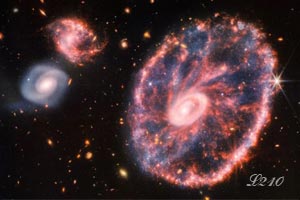
The cartwheel (James Webb Space Telescope).
The intelligence and consciousness of each human being, combined with the ability to communicate, allows the group to expand the consciousness of each individual.
«Man perceives himself as intelligent.
However, it is his 37,200 billion cells working in harmony
that express their own intelligence. »
However, it is his 37,200 billion cells working in harmony
that express their own intelligence. »
d – The evolution towards abstract languages :
1 – Mathematics :
Mathematical and intellectual activity rarely leaves traces that can be exploited by archaeology. As a result, little is known about prehistoric mathematics.
The Ishango bones, discovered in the Congo and dated to around 20,000 years ago, seem to indicate the practice of arithmetic. However, the results obtained remain controversial.
Considering the current existence of ethnic groups that make do with arithmetic based on the numbers 1, 2, 3 and many, we can nevertheless assume that a simple numerical representation, sufficient for information and trade, may have already existed.
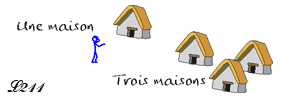
Few houses.
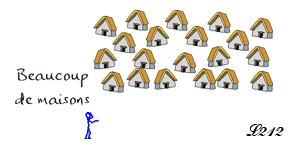
Many houses.
However, it was only with the birth of writing that the first practical mathematics were attested (in economics, for area calculations). The first positional number system appeared, based on the sexagesimal system. The first positional number system appeared, based on the sexagesimal system. For nearly two thousand years, thanks to the support of writing, which allowed calculations to be preserved and transmitted, mathematics developed in the regions of Sumer, Akkad and then Babylon. This led to complex calculations, such as algorithms for extracting square roots and cube roots, and solving quadratic equations.Some tablets contain lists of Pythagorean triples, showing that the Sumerians knew about the properties of right-angled triangles more than 1,000 years before Pythagoras.
Around 1000 BC, there was also a development in calculation focused on astronomy.
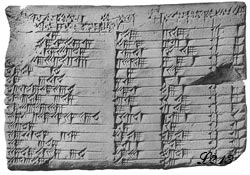
Plimpton 322, a Babylonian tablet listing Pythagorean triples.
In Egypt, the best sources on mathematical knowledge are the Moscow Papyrus (1850 BC) and the Rhind Papyrus (1800-1550 BC), which is over 5 metres long and contains 87 solved problems in arithmetic, algebra, geometry and surveying.
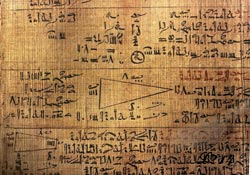 |
 |
The Moscow Papyrus and the Rhind Papyrus.
The Egyptians mainly used mathematics for calculating wages, calculating area and volume, managing crops, and for irrigation and construction work.
In Mayan civilisation (2600 to 1500 BC), mathematics was mainly numerical and focused on calendar calculations and astronomy.
More recent traces of mathematical calculations can be found in China, India and Greece.
Could mathematics also be considered a language? This is what Galileo contemplated in his 1623 work « The Assayer ».
« Philosophy (here synonymous with science) is written in this vast book that is constantly open before our eyes – I mean the universe – but we cannot understand it unless we first learn to understand the language and know the characters in which it is written. Now it is written in mathematical language, and its characters are triangles, circles, and other geometric figures, without which it is impossible to understand a single word, without which one truly wanders in a dark labyrinth. »
While mathematical calculations make it possible to represent shapes and trajectories that evolve over time, they also facilitate trade. They can therefore be considered a means of communication.
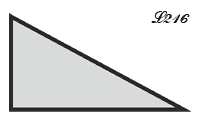
Triangle.

Earth's orbit according to the seasons.
Their transformation over time reflects not only new needs that encourage communication within communities (trade, construction, etc.), but also the evolution of communication between brain cells.
Two teams of researchers, one from INSERM led by Stanislas Dehaene and the other from La Salpêtrière led by Laurent Cohen, have shown that calculations mainly involve two pathways in the brain : a language pathway, which corresponds to the automatic manipulation of numbers and is expressed through calculation formulas, and another pathway, known as the semantic pathway, which deals with the meaning of numbers. The latter is believed to be the dominant pathway.
In addition, mathematics offers multiple possibilities for understanding the environment and predicting events. It thus complements information received by the eye (such as seeing the Sun and the Moon) and, based on a calculation, allows us to determine future events (an eclipse, for example).
The result obtained, translated into verbal language, then allows the information obtained to be transmitted.
Mathematics therefore fits into language as a means of clarifying the answer to a question.
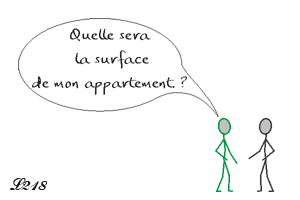
The question asked...
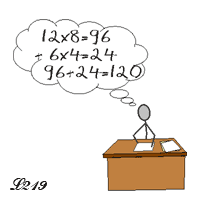
...requires a calculation...
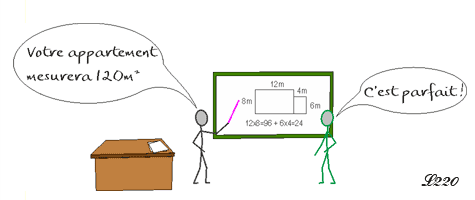
...to obtain an answer.
We could therefore say that mathematical language is a self-referential language, an internal language that allows us to obtain the desired answer by giving it greater precision. To be understood, this answer must be translated into verbal language.
« Thanks to a coded language, mathematics allows us to
find answers to the questions we ask ourselves. »
find answers to the questions we ask ourselves. »
2 – Lambda calculus :
How can mathematical languages be included in the wider family of languages ?
Lambda calculus, a language invented in 1932 by the American mathematician Alonzo Church to solve questions of pure logic, could give us a clue.
In the 1950s, logicians and linguists saw in this language the logical structures underlying natural languages in which all statements and words can be viewed as computer programmes.
Used for 50 years by computer scientists to write their software, this language makes it possible to update the logic underlying natural languages in a much clearer and more concise way than any other linguistic theory.
This language was taken up by Jean-Louis Krivine, a French mathematician and logician who saw in it the logical structure that governs our brain functions.
In concrete terms, the similarity that can be imagined between a computer and the brain would not be at the level of the machine itself, made up of printed circuits or neurons, but at the level of the software system implemented in the memory.
Lambda calculus would intervene between the layer of electronic circuits and the advanced programming language used by computer scientists to write their software: the idea would be that our brain works in this way.
PFor Jean-Louis Krivine, several layers would overlap in both a computer and our brain, and the languages spoken by human beings could be seen as the interpretation, in an elaborate language, of the underlying neural calculations.
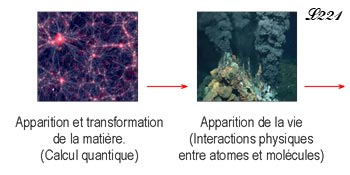
Organisation...
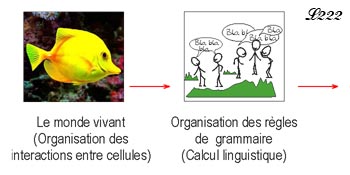
...of the different layers...

...of Lambda calculus.
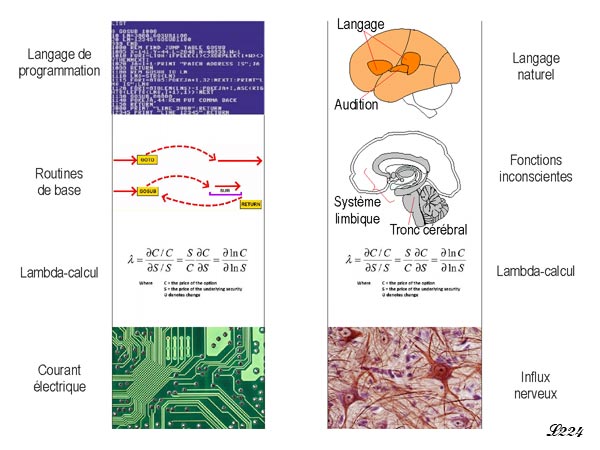
Similarities between programming language and natural language.
The discovery of a structure common to 6,000 languages and dialects would reinforce the existence of this layer of lambda calculus common to all human beings.
In 1931, Austrian logician Kurt Gödel demonstrated a famous theorem: the incompleteness theorem.
By translating the proof of this theorem into lambda calculus, Jean-Louis Krivine deduced that it corresponded to the repair programme for a computer's file system.
This computer programme, present in all computers, intervenes when the machine is suddenly shut down before the running programmes are closed : during the next start-up, while the computer cannot be used, it scrolls through the files and repairs those that have been altered.
Kurt Gödel would therefore have developed a computer programme essential to the proper functioning of a computer, before it was even invented !
According to Jean-Louis Krivine, this programme is also present in our brains, coming into operation during sleep, and dreams are precisely a means of restoring the altered “files” to their original state.
For some linguists, ‘Krivine's theory is the first serious clue to the origin of hominid language. »
« According to Krivine's thesis, lambda calculus mimics brain activity
and could explain brain activity during REM sleep :
it serves to restore programmes that have been altered during daytime activities. »
and could explain brain activity during REM sleep :
it serves to restore programmes that have been altered during daytime activities. »
3 – Physics :
Physics is the study of matter and its fundamental properties.
Theories such as special relativity (1905), general relativity (1915) and quantum mechanics enable us to describe phenomena at the atomic and subatomic level, phenomena that are often completely unknown to the average person because they are inaccessible to the senses.
This science, which relies on mathematical language, complements it by enabling the design of tools, true extensions of the eye and ear, which receive the information sought.

The telescope, an extension of the human eye.

The radio telescope, an extension of the human ear.
Physics then makes it possible to decode the different waves coming from the sky in order to translate them into images. It thus becomes the tool that allows us to hear and understand the language of the Universe, whether infinitely large or infinitely small, in order to transform what is invisible to us into images accessible to our senses.
However, can a radio telescope really be compared to an eye or an ear?
To answer this question, we must first ask ourselves what a wave is.
A wave is a disturbance that propagates through the surrounding space. This disturbance does not transmit matter but energy, the value of which depends on its nature and intensity.
There are three main types of waves:
Mechanical waves, which propagate through physical matter, causing the substance to deform.
Electromagnetic waves, which propagate by causing variations in the magnetic and electric fields. They do not require a physical medium.
Gravitational waves also do not require a medium. They are deformations in the curvature of space-time that propagate.
These three types of waves vary in length.
Mechanical waves consist of infrasound, sound and ultrasound. Only sound can be heard by humans.
Electromagnetic waves consist of radio waves, microwaves, infrared radiation, visible light, ultraviolet radiation, X-rays and gamma rays. Only visible light waves are perceptible to us.
Gravitational waves are not accessible to our senses and must be interpreted in order for us to access them.
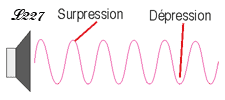
Sound waves.

Propagation of mechanical and electromagnetic waves.

Propagation of gravitational waves.
Now let's look at an image of a starry sky.

Starry sky.
Once detected, visible light waves are translated into images by the brain, which then translates the images into verbal language and transmits them via mechanical sound waves.

From vision to language. (electromagnetic waves).

From language to vision. (mechanical waves).
Now let's hear the words ‘starry sky’ and see them appear in curves on the screen: the waves made up of a succession of sound frequencies are indeed elements of a language that conveys information.

The sequence of sound frequencies...
...is reproduced in the sentence : « Starry sky. »
Just as our brain translates the light waves it perceives into images before transforming them into sound waves to share them, machines perform a similar task with electromagnetic and gravitational waves.

Stars – gravitational waves – radio telescope – computer translators – image – eye
Thus, the various types of radiation coming from the universe, which are imperceptible to our senses, can be translated into images and reveal the evolution of phenomena to us.
It was then that black holes, the most invisible objects in the universe, appeared before our eyes.
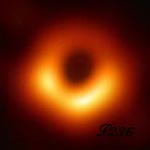
The accretion disc of black hole M87*
imaged by the Event Horizon Telescope.
imaged by the Event Horizon Telescope.
Even if we cannot communicate with the Universe by calling out to it, we can ‘hear’ what it tells us.
So when we manage to capture its radiation and translate it into images, we cannot help but be struck by its beauty. At that precise moment, it says to us : « Am I not extraordinary ? ».
 |
 |
« Am I not surprising ?» NGC1909 - The Witch Head Nebula. |
« Am I not pretty ?» . |
Through its radiation, the Universe communicates with us.
Perhaps one day, once our senses are awakened, we will be able to feel its presence and hear it directly. But first, we must begin by listening to what our Earth is telling us, which is all too often undermined by our blindness.
 |
 |
« Am I not human ?» |
« Are we not alive ?» |
« By analysing the waves coming from the Universe,
physics allows us to understand the information it sends us. »
physics allows us to understand the information it sends us. »
« The sounds of a language can be represented by waves...
Could we generalise by saying that
any wave that communicates information is a language ? »
Could we generalise by saying that
any wave that communicates information is a language ? »
4 – Programming languages :
The first programmes that can be described as computer programmes date back to 1936. They were mainly intended for calculating machines or tools performing repetitive tasks, such as the Jacquard loom, the first programmable system using punch cards.
A little later, in the 1940s, the first electric computers of the modern era appeared.
Then, in the 1950s, the first three modern programming languages were designed to:
- translate formulas (FORTRAN).
- process lists (LISP),
- program management applications (COBOL).
From the 1990s onwards, languages multiplied, but remained the preserve of specialists, who were the only ones capable of designing and using themr.
Developed in the manner of a natural language, these mathematical languages are composed of grammar rules, an alphabet and a vocabulary in which each word has a meaning.
However, while these languages allow a machine to be operated or information to be searched for in a memory using predefined code, their automatic nature does not yet allow them to facilitate the exchange of ideas.
Currently, these programming languages have evolved to enable the processes created to become autonomous by learning and exchanging information with other machines [see: Developments in artificial intelligence :]. These are robots whose programmes are connected to the outside world via various sensors (2D/3D cameras, vibration sensors, proximity sensors, accelerometers, etc.). The environmental data collected can then be used in real time.
The term ‘artificial intelligence’ therefore refers to a category of systems that enable machines to reproduce the capabilities of living beings.
It should be noted that what makes them ‘intelligent’ is not ‘language’, but the senses with which they have been equipped, which open them up to an ever-changing environment.
Today, while developments in artificial intelligence make it possible to simulate amusing ‘conversations’ or facilitate manipulation, their real value lies in providing access to information that only a machine open to the outside world can reach.
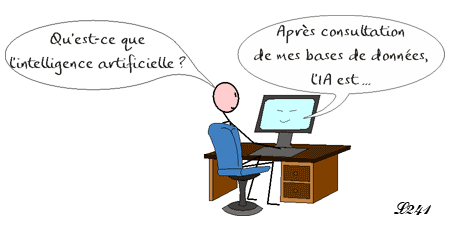
« Programming language remains limited to controlling a machine
capable of searching for information. »
capable of searching for information. »
5 – The development of language in robots :
However, programming language could open up other horizons.
As we have seen, many scientific disciplines are indirectly attempting to trace the origins of language by transposing current knowledge onto the past.
But there is another approach, which involves observing entities created from scratch, inventing and then sharing vocabulary and syntax from nothing.
This feat was achieved in a Parisian laboratory by artificial intelligence researchers led by Luc Steels of the Sony Computer Science Laboratory (Sony CSL). To do this, they observed the behaviour of... robots playing ball!
This work yielded two key findings : the time required for a language to emerge is very short, and chance plays a key role. This calls into question the existence of a ‘mother tongue’ that is the origin of all other languages.
Let's follow the course of the experiment.
Two Aibos (the famous little robot dogs created by Sony) move around an orange ball placed on the floor.
Suddenly, they both stop and emit a sound signal. Each has found a position that allows it to see both the ball and its partner.

Aïbo 1 et 2.
An experimenter then gives the ball a push and it starts to roll. The two robots follow its movement closely.
When the ball stops, the first Aibo emits a series of incomprehensible sounds via its audio transmitter that correspond to the ball's movement and could be translated as: ‘the ball went to the left’... A few seconds later, the second Aibo nods “yes” or ‘no’.
Then the two Aibos switch roles, and the experimenter throws the ball again.
Thanks to these repeated sound exchanges, the two robots gradually create a common language that allows them to describe the ball's movements.
Thus, it took only 5,000 ball throws for the two robots to create sentences such as ‘pugiza titelu’ or ‘pugiza remibu voxuna’, which describe the movements of the ball and mean, for example, : « the ball went to my left » « the ball is rolling towards you ».
At the start of the experiment, which began in 2004, the robots had no words or grammatical rules stored in their memory : their language was created from scratch!
To achieve this result, however, the researchers had to implement three cognitive abilities found in humans into the hard drive of each Aibo.
- The first is to compartmentalise perceived visual reality by creating all kinds of categories to describe it.
For example, the location of the ball, its direction, its speed of movement, or the distance travellede.
Then they will associate randomly chosen sounds (‘words’) with each of these categories.
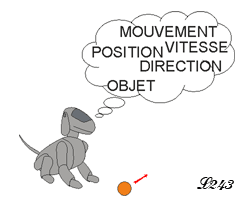
Aïbo 1.
- The second ability consists of randomly creating words and grammatical rules when faced with a new situation, even though they have no language.

Aïbo1.
- The third ability allows each Aibo to constantly coordinate its own tools with those of the other.
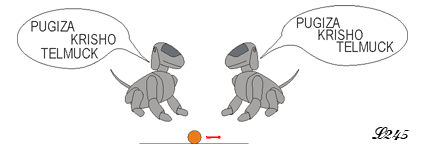
Aïbo 1 et 2.
Let's go back to the beginning of the experiment.
The two Aîbos must, for example, create words meaning ‘the ball has moved to the left’ and integrate them into their common vocabulary.
As the two robots come to a standstill, the experimenter intervenes to move the ball.
The ball rolls to its left. In the mind of Aibo1, which is supposed to speak first, this event has already been broken down (this is its primary ability) into a multitude of categories: location, movement, speed, distance travelled by the ball
However, Aibo1 cannot describe the event because it does not yet have the words to designate it. Using his second ability, he generates the words ‘krisho telmuck’ (which can be translated as ‘moved left’).
How will Aîbo2 react ? Since he also has no words available, he turns his head from right to left, indicating that he does not understand. However, it has memorised the type of movement of the ball it has just observed, and the vocalisation used by its partner.
Now let's imagine that after yet another throw, Aibo2 observes an identical movement and has to describe it. As it has the first throw stored in its memory, it will be able to use the words invented by Aibo1, ‘krisho telmuck’, thus using its third ability, namely the ability to match its own linguistic tools with those of its partner.
At these words, Aîbo1 will nod ‘yes’: ‘krisho telmuck’ is now part of the lexicon shared by both robots.
The mere presence of the three abilities mentioned above was enough to bring about the emergence of a common language. It should be noted that the robots, free to invent any vocalisation, would create a completely different language if the experiment were repeated.
C - The source of verbal language :
Can these results be extrapolated to humans ?Yes, thanks to the work of American linguist Judy Kegl, who described the emergence of Nicaraguan sign language in the 1980s.
After they were brought together, and all attempts to teach them various means of communication failed, the children spontaneously invented a completely new sign language that enabled them to communicate with each other within a few months. Using only their cognitive abilities, they had succeeded in creating a language that did not previously exist
Although this discovery, corroborating Steels' research, seems to contradict the existence of a first mother tongue, this is not the case.
Spoken language is a language of sounds. In all animal species, these sounds describe situations and behaviours before words are used to specify the nature of objects. Thus, Campbell's mone can describe situations using its syntax, but danger coming from the sky or the ground is determined by sight before being transformed into vocalisation.
Similarly, as the use of sounds is impossible for deaf children, the language of Nicaragua has naturally exploited vision to achieve communication through gestures, for which human beings are already prepared, like any animal of another species: observation, imitation and memorisation provide for this.
No language is needed to imitate or learn,
seeing is enough.
seeing is enough.
The same applies to Aibos. Although they cannot speak initially, they recognise images, in this case objects (balls) or partners, movements and gestures (head movements). By recognising shapes, attitudes and movements, they already possess a visual syntax that they can translate into sounds.
« For Aibo, as for monkeys and deaf children,
vision is the origin of language. »
vision is the origin of language. »
From verbal language to its transcription into symbols. (in french)
Bibliography :

